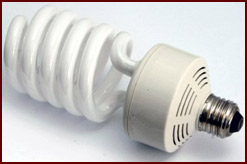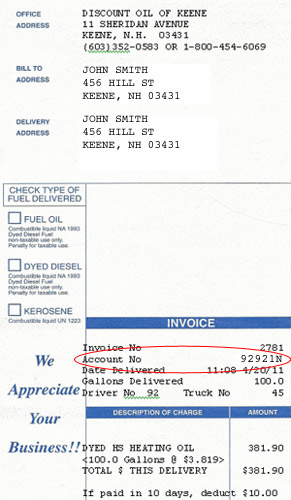Our Services

Discount Oil's conservation experts have helped hundreds of customers reduce their carbon footprints and lower their energy costs with solid advice and advanced equipment. We provide conservation guidance to our regular customers at no charge, including inspecting and evaluating their heating systems and controls.
We install excellent cost-saving equipment, including programmable thermostats, flame retention burners and high-efficiency heating and cooling systems. We also install radiant heating systems that can greatly improve a home's comfort while also saving energy.
If you would like conservation advice from a Discount Oil specialist, please call us today or
contact us online.
Cold Weather Tips
- Insulate your electric hot water heaters. The U.S. Department of Energy recommends that you insulate the tank or water heater and the first six feet of hot water pipe.
- Have your heating system tuned. A well-tuned boiler or furnace burns 5 percent less fuel.
- If you have a furnace, clean or replace the air filter once a month to assure the best airflow and efficiency. Make sure that furniture or draperies do not block vents.

- Upgrade your heating system. Homeowners who have older Oilheat systems can lower their fuel costs by 30 percent or more by installing a new, high-efficiency system. New designs incorporate technologies like condensing and multi-stage operation to squeeze every ounce of heat from the system. The savings provide a remarkable return on investment that keeps paying off year after year - every time the weather turns cold.
- Sunshine! Windows on the south side of the house get the most sunlight. Eastern windows get sunlight in the morning. West facing windows receive sunlight in the afternoon. Open shades and drapes during the daytime and close when the sun goes down.
- Seal off your attic-circulating fan with polyethylene and tape.
- Wrap your pipes, to guard against heat loss and prevent them from freezing.
- Avoid using space heaters. They're expensive to operate and can be dangerous.
[ Back to top ]
Warm Weather Tips
- Keep drapes, blinds and shades closed during the day to block out the sun.
- Clear furniture away from air conditioning vents.

- Install an attic fan - it can cool your attic by nearly 30 degrees!
- Plant shade trees due west of west windows. It could reduce your air conditioning bills by up to 25 percent!
- Cook on the grill to keep cooking heat outside the home.
- When cooking inside, use a microwave instead of a conventional oven. It uses less than half the power and cooks food in about one-fourth the time.
- Install reflective window coatings to reflect heat away from your home.
[ Back to top ]
Year-Round Tips
These tips can help save energy in every season.
- Install a digital programmable thermostat. It puts your heating and cooling systems on an automatic schedule: full heat or cooling during hours when the home is active, and less when the house is empty or the family is asleep. The U.S. Department of Energy (DOE) says that setting back a home's temperature by 10 to 15 degrees for eight hours a day can reduce total heating and cooling costs by 5 to 15 percent.
- Insulate thoroughly to eliminate heat transfer through your walls, ceilings and floors. You could reduce your heating and cooling costs by as much as 15 percent, according to Consumer Energy Council of America.
- Replace outdated appliances with high-efficiency units to reduce energy consumption.

- Replace incandescent light bulbs with compact fluorescent light bulbs (CFLs), that use only 25 percent as much energy and last 10 times as long.
- Reduce water heater temperature setting to 120 degrees F to save fuel. (You'll also reduce the risk of scalding.)
- Add caulking and weather-stripping around doors, attic access, windows, outdoor faucets and any areas where there might be leaks. (As much as 40 percent of your heating and cooling costs can be due to air leaks.) Check caulking at least once a year and replace material that has dried out and shrunk.
- Install rubber gaskets behind outlets and switch plates on exterior walls. (Gaskets can be found in most home improvement stores.)
- Check weather-stripping and door sweeps at least once a year and repair or replace them as needed.
- Repair and weatherize your storm windows.
- Close off rooms you don't use - and remember to shut the vents inside.
- Install dimmer switches. In addition to enhancing the mood, they'll extend the life of your bulbs and help you save up to 60 percent on your lighting costs.
- Install motion activated switches that automatically turn lights on and off.
- Install water-conserving fixtures, such as showerheads, faucets and toilets.
- Fix leaky faucets, especially hot water faucets. One drop per second can add up to 165 gallons per month - more than a person uses in two weeks.

- Take showers instead of baths. A five-minute shower will use about 7.5 gallons of hot water; filling a bathtub can use up to 20 gallons.
- Keep ductwork in good repair by sealing leaks with mastic, metal-backed tape. Your home could be losing up to 25 percent of its heated or cooled air before it reaches the vents!
- Install ceiling fans. They could cut your energy bill for cooling by 40 percent.
- Use efficient temperature settings for your refrigerator and freezer. Recommended temperatures are 37 to 40 degrees F for the refrigerator and 5 degrees F for the freezer.
- Don't leave the fridge door open! Every time you do, up to 30 percent of the air inside can escape. The same can be said for your oven.
- Use less water and use cooler water when doing laundry. The warm or cold water setting on your machine will generally do a good job of cleaning your clothes. Switching your temperature setting from hot to warm can cut a load's energy use in half.
- Consider air-drying clothes on clotheslines or drying racks. Clothing manufacturers recommend air-drying for some fabrics.
- Use a covered kettle or pan to boil water; it's faster and uses less energy.
[ Back to top ]
Resources
Here are some Web sites where you can learn more about Oilheat, energy, conservation and more.
National Oilheat Research Alliance (NORA) is an industry association for Oilheat.
www.noraweb.org
Oilheat America is NORA's consumer information site.
www.oilheatamerica.com
The Massachusetts Energy Marketers Association is an industry association for Oilheat dealers in the state.
www.massenergymarketers.org
Energy Answers Today compares Oilheat and natural gas.
www.energyanswerstoday.com
Bioheat Online is an information site about Bioheat for consumers and Oilheat dealers.
www.bioheatonline.com
ENERGY STAR® offers energy saving advice and information from the U.S. Environmental Protection Agency and the U.S. Department of Energy.
www.energystar.gov
The U.S. Energy Information Administration provides energy statistics from the U.S. Department of Energy.
www.eia.gov
[ Back to top ]


 Discount Oil's conservation experts have helped hundreds of customers reduce their carbon footprints and lower their energy costs with solid advice and advanced equipment. We provide conservation guidance to our regular customers at no charge, including inspecting and evaluating their heating systems and controls.
Discount Oil's conservation experts have helped hundreds of customers reduce their carbon footprints and lower their energy costs with solid advice and advanced equipment. We provide conservation guidance to our regular customers at no charge, including inspecting and evaluating their heating systems and controls.








